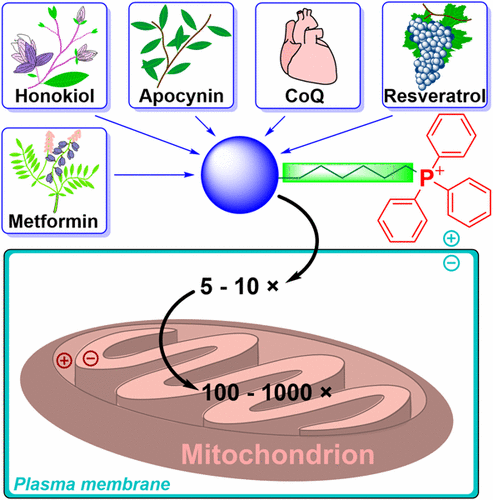当前位置:
X-MOL 学术
›
Chem. Rev.
›
论文详情
Our official English website, www.x-mol.net, welcomes your
feedback! (Note: you will need to create a separate account there.)
Mitochondria-Targeted Triphenylphosphonium-Based Compounds: Syntheses, Mechanisms of Action, and Therapeutic and Diagnostic Applications
Chemical Reviews ( IF 51.4 ) Pub Date : 2017-06-27 00:00:00 , DOI: 10.1021/acs.chemrev.7b00042 Jacek Zielonka , Joy Joseph , Adam Sikora 1 , Micael Hardy 2 , Olivier Ouari 2 , Jeannette Vasquez-Vivar , Gang Cheng , Marcos Lopez 3, 4 , Balaraman Kalyanaraman
Chemical Reviews ( IF 51.4 ) Pub Date : 2017-06-27 00:00:00 , DOI: 10.1021/acs.chemrev.7b00042 Jacek Zielonka , Joy Joseph , Adam Sikora 1 , Micael Hardy 2 , Olivier Ouari 2 , Jeannette Vasquez-Vivar , Gang Cheng , Marcos Lopez 3, 4 , Balaraman Kalyanaraman
Affiliation

|
Mitochondria are recognized as one of the most important targets for new drug design in cancer, cardiovascular, and neurological diseases. Currently, the most effective way to deliver drugs specifically to mitochondria is by covalent linking a lipophilic cation such as an alkyltriphenylphosphonium moiety to a pharmacophore of interest. Other delocalized lipophilic cations, such as rhodamine, natural and synthetic mitochondria-targeting peptides, and nanoparticle vehicles, have also been used for mitochondrial delivery of small molecules. Depending on the approach used, and the cell and mitochondrial membrane potentials, more than 1000-fold higher mitochondrial concentration can be achieved. Mitochondrial targeting has been developed to study mitochondrial physiology and dysfunction and the interaction between mitochondria and other subcellular organelles and for treatment of a variety of diseases such as neurodegeneration and cancer. In this Review, we discuss efforts to target small-molecule compounds to mitochondria for probing mitochondria function, as diagnostic tools and potential therapeutics. We describe the physicochemical basis for mitochondrial accumulation of lipophilic cations, synthetic chemistry strategies to target compounds to mitochondria, mitochondrial probes, and sensors, and examples of mitochondrial targeting of bioactive compounds. Finally, we review published attempts to apply mitochondria-targeted agents for the treatment of cancer and neurodegenerative diseases.
中文翻译:

线粒体靶向三苯基鏻基化合物:合成、作用机制以及治疗和诊断应用
线粒体被认为是癌症、心血管和神经系统疾病新药设计的最重要靶点之一。目前,将药物特异性递送至线粒体的最有效方法是将亲脂性阳离子(例如烷基三苯基鏻部分)共价连接至感兴趣的药效基团。其他离域亲脂性阳离子,例如罗丹明、天然和合成的线粒体靶向肽以及纳米颗粒载体,也已用于小分子的线粒体递送。根据所使用的方法以及细胞和线粒体膜电位,可以实现 1000 倍以上的线粒体浓度。线粒体靶向已被开发用于研究线粒体生理学和功能障碍以及线粒体与其他亚细胞器之间的相互作用,并用于治疗神经退行性疾病和癌症等多种疾病。在这篇综述中,我们讨论了将小分子化合物靶向线粒体以探测线粒体功能的努力,作为诊断工具和潜在的治疗方法。我们描述了线粒体亲脂性阳离子积累的物理化学基础、将化合物靶向线粒体的合成化学策略、线粒体探针和传感器,以及生物活性化合物的线粒体靶向的示例。最后,我们回顾了已发表的应用线粒体靶向药物治疗癌症和神经退行性疾病的尝试。
更新日期:2017-06-27
中文翻译:

线粒体靶向三苯基鏻基化合物:合成、作用机制以及治疗和诊断应用
线粒体被认为是癌症、心血管和神经系统疾病新药设计的最重要靶点之一。目前,将药物特异性递送至线粒体的最有效方法是将亲脂性阳离子(例如烷基三苯基鏻部分)共价连接至感兴趣的药效基团。其他离域亲脂性阳离子,例如罗丹明、天然和合成的线粒体靶向肽以及纳米颗粒载体,也已用于小分子的线粒体递送。根据所使用的方法以及细胞和线粒体膜电位,可以实现 1000 倍以上的线粒体浓度。线粒体靶向已被开发用于研究线粒体生理学和功能障碍以及线粒体与其他亚细胞器之间的相互作用,并用于治疗神经退行性疾病和癌症等多种疾病。在这篇综述中,我们讨论了将小分子化合物靶向线粒体以探测线粒体功能的努力,作为诊断工具和潜在的治疗方法。我们描述了线粒体亲脂性阳离子积累的物理化学基础、将化合物靶向线粒体的合成化学策略、线粒体探针和传感器,以及生物活性化合物的线粒体靶向的示例。最后,我们回顾了已发表的应用线粒体靶向药物治疗癌症和神经退行性疾病的尝试。






























 京公网安备 11010802027423号
京公网安备 11010802027423号